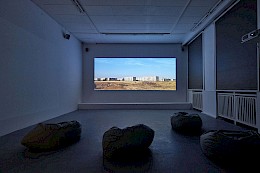Uriel Orlow’s artistic practice is defined by a research- and process-oriented approach and the recurring use of the media film, photography, drawing, and sound. Using these he designs multimedia installations in which he relates different image regimes and narrative modes. His interest centers on the exploration of concealed micro-histories, whose specific locations and spatial inscriptions he reveals and investigates in his works.

Remnants of the Future
Produced by Uriel Orlow in 2010, the video Remnants of The Future examines the abandoned housing project “Mush” in the north Armenian city of Gyumri. It was initiated in 1988 by the Soviet government in order to give the victims of the Spitak earthquake a new livelihood based on the concept of “communal living.” However, the break-up of the Soviet Union in 1991 brought the work there to an abrupt end, and the planned development since then has remained in a state of incompletion and ongoing decay. By means of numerous documentary sequences, Orlow’s video traces the peculiar characteristics of this context, capturing in the process the slow reconquering of the buildings by nature and the solitary everyday life of the few people still living there. In various ways the “Mush” development can thus be seen as one of those lost places that seemingly exist well away from the late-capitalist promise of prosperity and progress. Urlow ultimately counters this situation defined by a lack of prospects, stagnation, poverty, and flight with a new alternative, in which the failed ideas of the past are associated with the anticipation of a utopian vision of the future.









